Greddy Turbo Upgrade - Upgrade.....
#76
And this has nothing to do with SC - why did you even mention SC - wtf ?
#77
I don't know what to say to convince you otherwise.
#78
This is taking into account the turbo and all the associated pipework back as far as the flange that connects to the midpipe and comparing it to a stock manifold - yes ?
#79
Because I've literally spent years arguing with you on this topic, and all through it you've been steadfast on the idea that a turbo is "hot" and therefor not good. That has been your false mantra of SC > TC. Never mind that the whole point of the engine is to burn fuel and it becomes a heat generator more than anything else. Making use of the heat is not bad, in fact it's ideal.
I don't know what to say to convince you otherwise.
I don't know what to say to convince you otherwise.
All I was pointing out here is that heat is an issue - and you guys jump all over me .
Sorry for this threadjack Kane
#80
I look at it this way:
say for simplicity sake that you are running enough boost to increase the mass flow of your engine both in air and fuel to 150% of N/A. There is a natural temperature achieved ideally within the engine. This has to do with the energy released in combustion and the energy absorbed by all the components (including inert) that drives the expanding force. So, now you have 150% of the energy released and 150% of the mass to absorb it. However, there is also a fix amount of coolant flow that is still at the N/A mass rate and an engine system/manifold/other components that are also of their original N/A mass. So the amount of heat syphoned off to those systems doesn't go up much. As the internal temperature rises, the heat transfer rises (thus placing greater demand on cooling systems) but that at it's root is driven by higher achieved temperatures, heat transfer being driven by temperature difference. So, now you have 150% of a mass flow exiting at the engine at a somewhat elevated temperature compared to N/A and you are going to put it through a curly-q manifold to turbine to down pipe path. By increasing the temperature some and the path some, you have increased the amount of heat transfered from the exhaust while it is in the engine bay. The increase in mass flow rate probably exceeds these factors but I couldn't rightly say. If you have 150% of the mass flow, you have 150% of the raw heat energy of before and the surroundings will have to absorbe 150% of the heat before to achieve the same exhaust cooling. So, if the exhaust cools 400 degrees N/A, it will put more heat into the environment in this scenario by only cooling 300 degrees. The larger sustained temperature difference will also drive up the heat transfer speed.
A lot of this can be understood just by comparing getting hit by a small burning campfire ember and trying to grab one of the logs from the fire. Mass can make a significant difference. Some of this is altered by running richer boosted mixtures which can provide greater system mass without increasing the amount of combustion that occurs. Water injection is the same principal.
It makes perfect sense to me that the heat damage from a turbo system could be significant in small confines even at high design quality standards. It's pretty much a direct biproduct of trying to burn more fuel to produce more power.
say for simplicity sake that you are running enough boost to increase the mass flow of your engine both in air and fuel to 150% of N/A. There is a natural temperature achieved ideally within the engine. This has to do with the energy released in combustion and the energy absorbed by all the components (including inert) that drives the expanding force. So, now you have 150% of the energy released and 150% of the mass to absorb it. However, there is also a fix amount of coolant flow that is still at the N/A mass rate and an engine system/manifold/other components that are also of their original N/A mass. So the amount of heat syphoned off to those systems doesn't go up much. As the internal temperature rises, the heat transfer rises (thus placing greater demand on cooling systems) but that at it's root is driven by higher achieved temperatures, heat transfer being driven by temperature difference. So, now you have 150% of a mass flow exiting at the engine at a somewhat elevated temperature compared to N/A and you are going to put it through a curly-q manifold to turbine to down pipe path. By increasing the temperature some and the path some, you have increased the amount of heat transfered from the exhaust while it is in the engine bay. The increase in mass flow rate probably exceeds these factors but I couldn't rightly say. If you have 150% of the mass flow, you have 150% of the raw heat energy of before and the surroundings will have to absorbe 150% of the heat before to achieve the same exhaust cooling. So, if the exhaust cools 400 degrees N/A, it will put more heat into the environment in this scenario by only cooling 300 degrees. The larger sustained temperature difference will also drive up the heat transfer speed.
A lot of this can be understood just by comparing getting hit by a small burning campfire ember and trying to grab one of the logs from the fire. Mass can make a significant difference. Some of this is altered by running richer boosted mixtures which can provide greater system mass without increasing the amount of combustion that occurs. Water injection is the same principal.
It makes perfect sense to me that the heat damage from a turbo system could be significant in small confines even at high design quality standards. It's pretty much a direct biproduct of trying to burn more fuel to produce more power.
Last edited by maxxdamigz; 08-06-2008 at 01:39 PM.
#81
ah, I see. Well Kane might have had issues, but I don't think it's an issue as it appears to be a rare event.
Also I think you're confusing all the intake piping from the turbo into the intake manifold with the exhaust part of the turbo system. What's cool is that even if you're not in boost, just the little bit of spinning the turbo does while cruising is enough to raise the intake manifold pressure and you will feel power increase on light throttle. That's one of the reasons why I recirculated my synchronic BOV. When it was not in boost, that air was being vented instead of directed into the manifold. So I lost that "edge" till there was enough boost to seal the BOV. This effect is pronounced with the 3071R. With the GReddy turbo, not so much, as it seems to be either "off" or "on".
Last edited by mysql; 08-06-2008 at 01:42 PM.
#82
The turbo, manifold and downpipe physically occupy the exact same space as the OE manifold, only it has less surface area.
Have you even looked at the two?
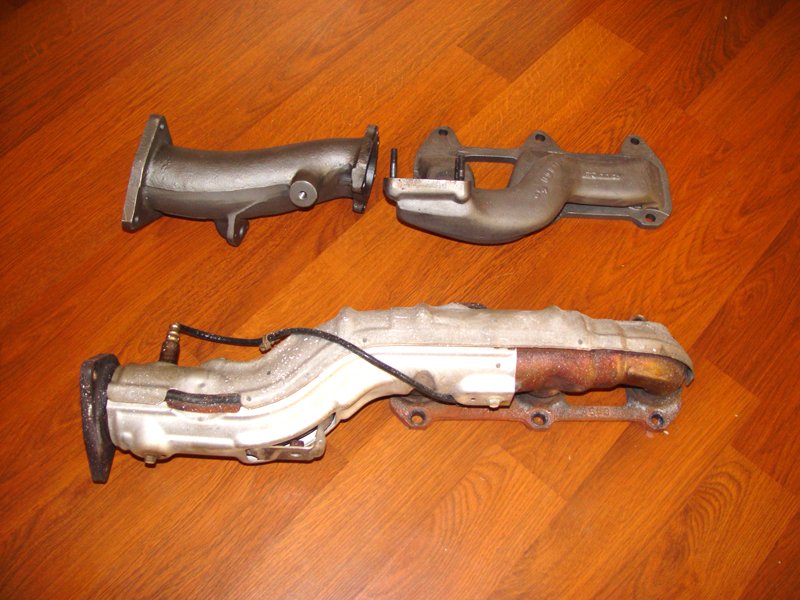
A typical street-driven turbo-modified car spends a very small fraction of its time on the road producing more power than a non-modified version.
#83
I should think that having a small surface area manifold is a bonus as you would rather keep the exhaust energy (heat) confined within the pipes so that you can put it to work in the turbine which is perfectly suited for the temperature. That's the purpose of heat wrap, turbo blankets, ceramic coating with the added bonus that more heat in the exhaust is less heat in your passenger footwell. I have a Mazsport Tubular manifold and if it wasn't ceramic coated, I should think the amount of heat given off by the high surface area would be quite substantial.
I should hope so. If I were to maintain boost for as long as 20 seconds, I'd be going quite fast. Kane's issues seems to be a resultant of proximity rather than persistent excessive temperatures.
Originally Posted by MazdaManiac
A typical street-driven turbo-modified car spends a very small fraction of its time on the road producing more power than a non-modified version.
Last edited by maxxdamigz; 08-06-2008 at 01:58 PM.
#85
And the turbo only adds 30 sq/in to the total assembly, which still comes in under the total surface area of just the OE piece.
#86
the difference being that with a normal manifold you can easily contain and direct the heat away from the immediate area - yes ?
Can you give me that small consolation MM - heh
Can you give me that small consolation MM - heh
#87
A supercharger increases the mass flow rate of the system along the same lines of the turbo. You could claim that the turbo's longer exhaust path is a contributor to heat problems, but if MM's assembly actually has less SA than the stock piece, then the area of heat rejection actually favors turbo over SC with stock manifold. It doesn't really matter though. I should think that once the exhaust has exited the engine and you aren't worrying about catalytic converter longevity, exhaust heat should be easily dealt with.
When you think about it, nitrous can be the worst heat offender as it increases the amount of fuel burned disproportionately to the system mass.
When you think about it, nitrous can be the worst heat offender as it increases the amount of fuel burned disproportionately to the system mass.
#88
The heat shielding I use on my system is so good I can shove my hand in there after a dyno pull and not get burned.
The OE design has melted quite a few right-hand motor mounts, hence the TSB and revised part.
My RH motor mount doesn't even get warm.
There are no significant hurdles in shielding either - Mazda just chose not to do it since they were only concerned with having enough heat retained to light-off the CAT.
Kane's issue was once of direct conduction, not radiation or convection.
#91
well, I think all turbo systems are gonna be very hot, even if it's MM's **** happens, to all systems and stuff
BHR's Radiator leaks (just talked to a guy yesterday that bought it and said it leaked) and the greddy upgrade burned a hole, lulz
however, Kane's problem does seem more like direct conduction, since the hole it burned through was pretty small and objective
mine however.........woot......need heat shielding
BHR's Radiator leaks (just talked to a guy yesterday that bought it and said it leaked) and the greddy upgrade burned a hole, lulz
however, Kane's problem does seem more like direct conduction, since the hole it burned through was pretty small and objective
mine however.........woot......need heat shielding
#92
#93
#95
Thread Starter
Illudium Q-36 Space Moderator
iTrader: (1)
Joined: Jan 2007
Posts: 6,364
Likes: 43
From: PCB
You guys crack me up.
Go back and look at the pic of the downpipe and turbo blanket; I think we can all CLEARLY define my heat related issue - and that was one of direct conduction. The re-assembly phase drama comes from my desire to fix it as best I can "while I got the car up" without spending a billion dollars. And at this point; I think a high quality wrapping procedure should get me by until late 2009 or so - in which case I'll be back in the mainland anyway.
The question becomes what do I define as a high quality wrapping and shielding job; you'll see soon enough.
Go back and look at the pic of the downpipe and turbo blanket; I think we can all CLEARLY define my heat related issue - and that was one of direct conduction. The re-assembly phase drama comes from my desire to fix it as best I can "while I got the car up" without spending a billion dollars. And at this point; I think a high quality wrapping procedure should get me by until late 2009 or so - in which case I'll be back in the mainland anyway.
The question becomes what do I define as a high quality wrapping and shielding job; you'll see soon enough.
#96
We do our best
Go back and look at the pic of the downpipe and turbo blanket; I think we can all CLEARLY define my heat related issue - and that was one of direct conduction. The re-assembly phase drama comes from my desire to fix it as best I can "while I got the car up" without spending a billion dollars. And at this point; I think a high quality wrapping procedure should get me by until late 2009 or so - in which case I'll be back in the mainland anyway.
The question becomes what do I define as a high quality wrapping and shielding job; you'll see soon enough.
From the discussion we have just had it would seem all you have to do is get the offending pipe far enough away from the body add a little shielding and you will be sweet .
Go back and look at the pic of the downpipe and turbo blanket; I think we can all CLEARLY define my heat related issue - and that was one of direct conduction. The re-assembly phase drama comes from my desire to fix it as best I can "while I got the car up" without spending a billion dollars. And at this point; I think a high quality wrapping procedure should get me by until late 2009 or so - in which case I'll be back in the mainland anyway.
The question becomes what do I define as a high quality wrapping and shielding job; you'll see soon enough.
From the discussion we have just had it would seem all you have to do is get the offending pipe far enough away from the body add a little shielding and you will be sweet .
#98
Thread Starter
Illudium Q-36 Space Moderator
iTrader: (1)
Joined: Jan 2007
Posts: 6,364
Likes: 43
From: PCB
Ok, wrapping the downpipe; take 1
Step one - sand, clean and dry.
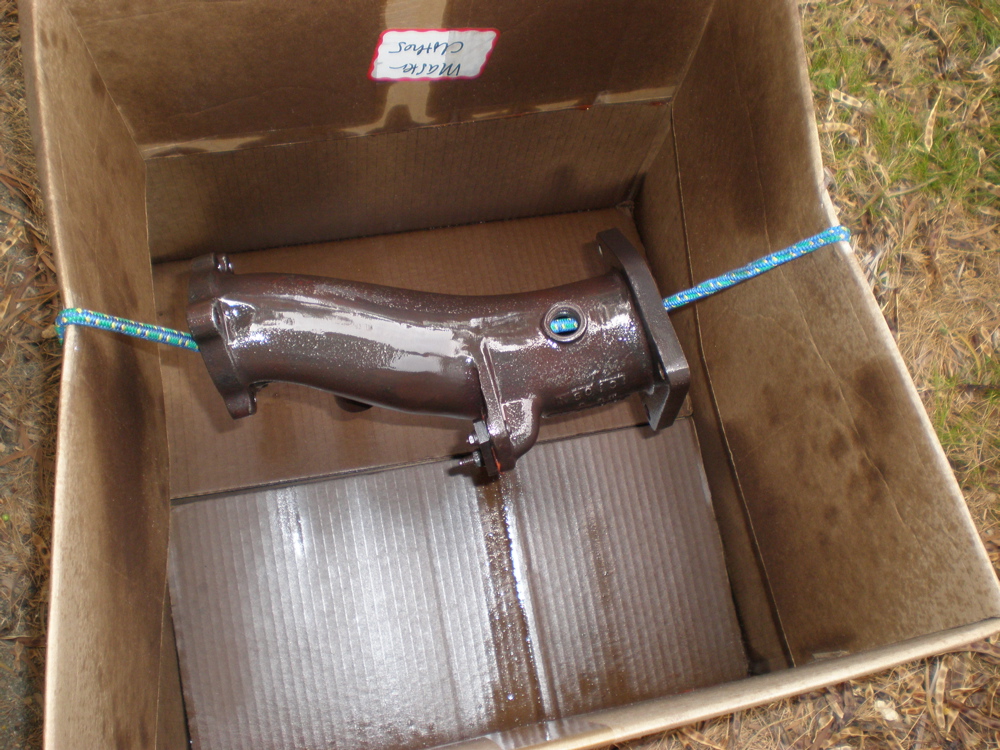
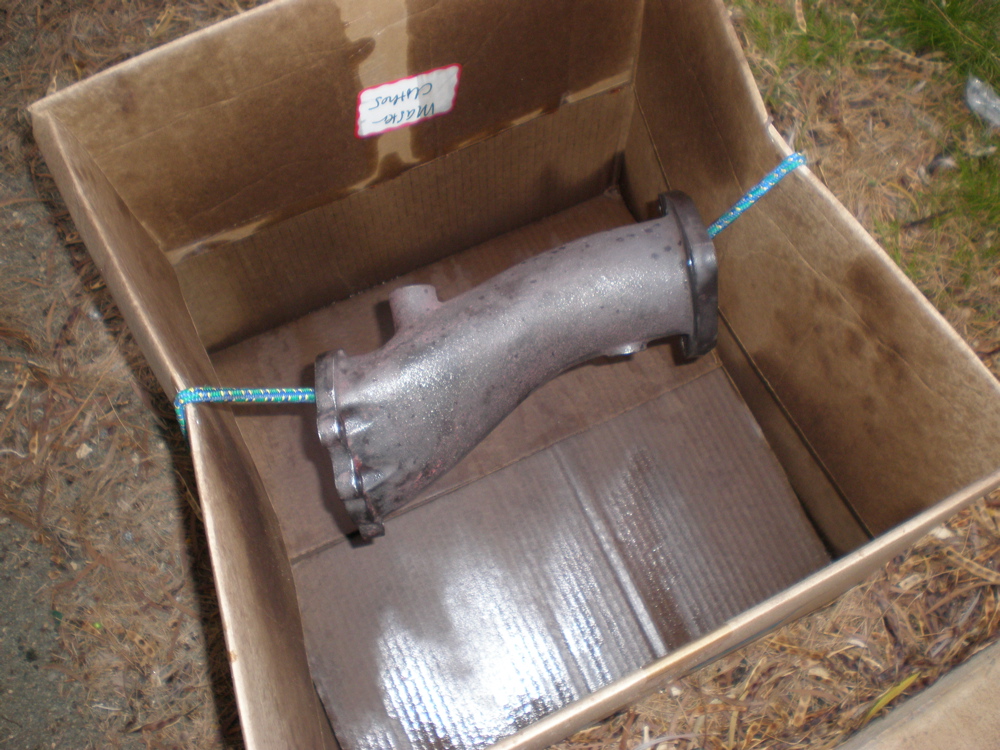
Step two - paint with 2000F ceramic paint to ensure rusting is controlled.

Step three - wrap with ceramic header wrap.


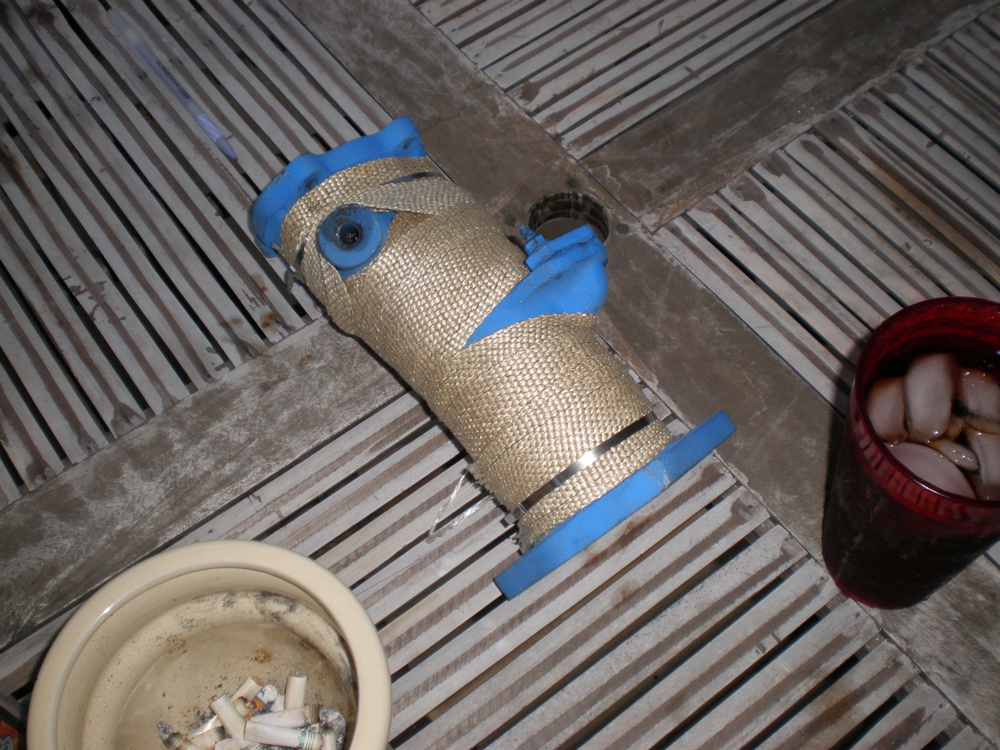
Step four - seal header wrap to prevent moisture seeping in.
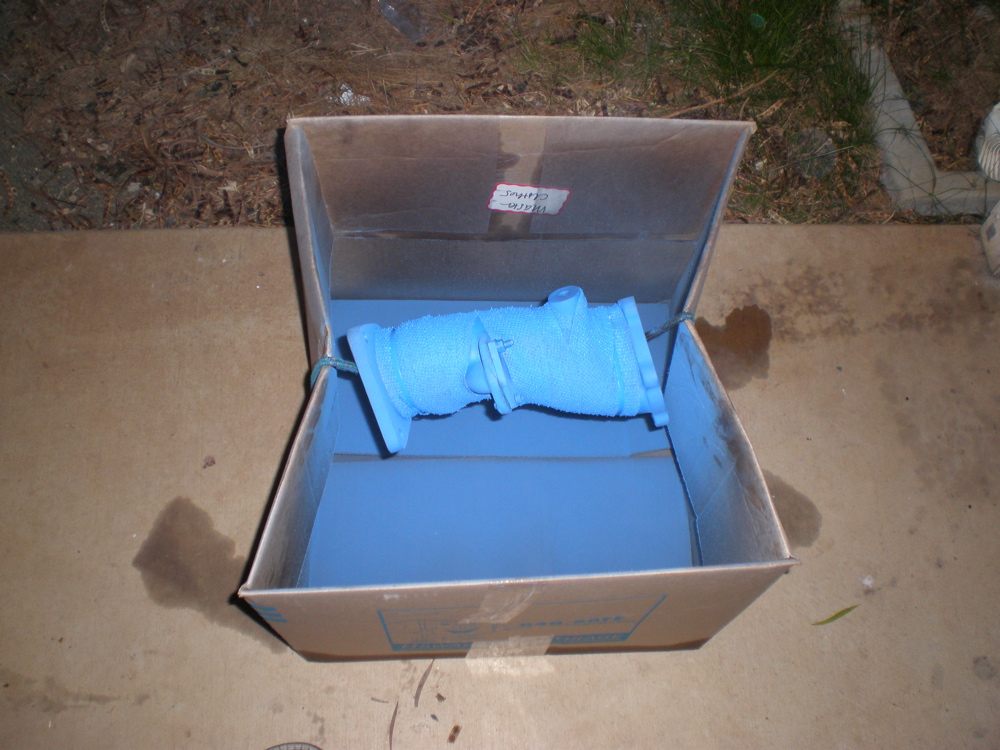
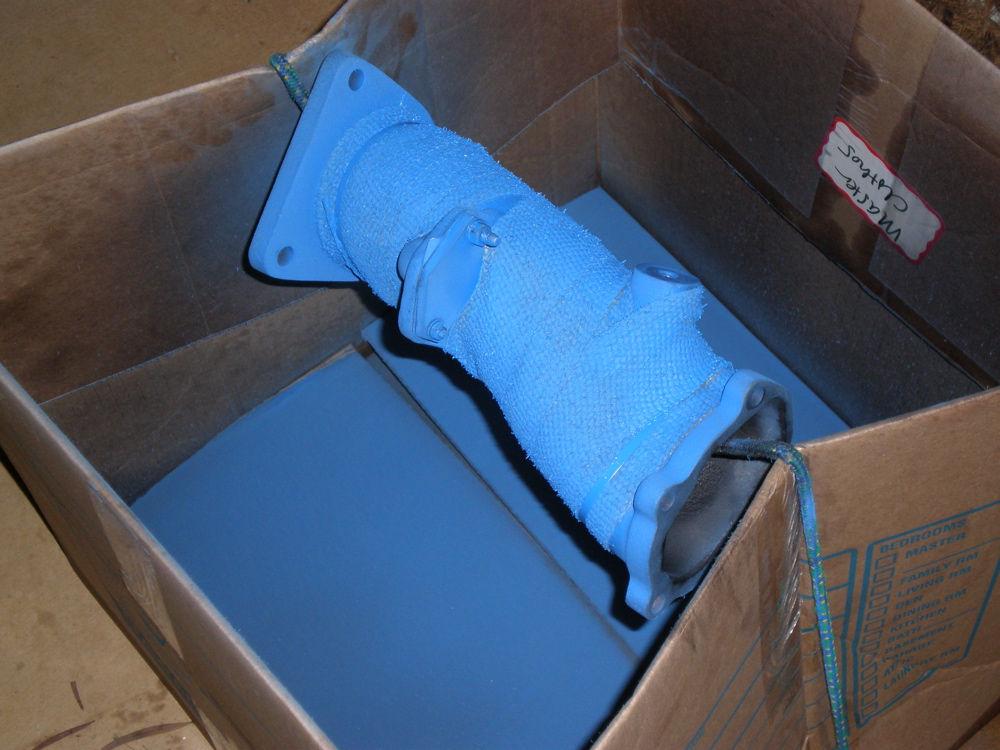
Step one - sand, clean and dry.


Step two - paint with 2000F ceramic paint to ensure rusting is controlled.

Step three - wrap with ceramic header wrap.



Step four - seal header wrap to prevent moisture seeping in.






